Related Research Articles

Syrah, also known as Shiraz, is a dark-skinned grape variety grown throughout the world and used primarily to produce red wine. In 1999, Syrah was found to be the offspring of two obscure grapes from southeastern France, Dureza and Mondeuse Blanche. Syrah should not be confused with Petite Sirah, a cross of Syrah with Peloursin dating from 1880.

Müller-Thurgau is a white grape variety which was created by Hermann Müller from the Swiss Canton of Thurgau in 1882. It is a crossing of Riesling with Madeleine Royale. It is used to make white wine in Germany, Austria, Northern Italy, Hungary, England, Australia, the Czech Republic, Slovakia, Slovenia, New Zealand, Canada, the United States and Japan. There are around 42,000 hectares (104,000 acres) cultivated worldwide, which makes Müller-Thurgau the most widely planted of the so-called "new breeds" of grape varieties created since the late 19th century. Although plantings have decreased significantly since the 1980s, as of 2006 it was still Germany's second most planted variety at 14,000 hectares and 13.7% of the total vineyard surface. In 2007, the 125th anniversary was celebrated at the Geisenheim Grape Breeding Institute. Müller-Thurgau is also known as Rivaner, Riesling x Sylvaner, Riesling-Sylvaner (Switzerland), Johannisberg, Rizvanec (Slovenia) and Rizlingszilváni (Hungary).
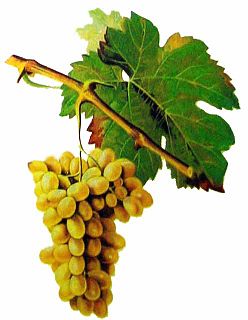
Clairette blanche is a white wine grape variety most widely grown in the wine regions of Provence, Rhône and Languedoc in France. At the end of the 1990s, there were 3,000 hectares of Clairette blanche grown in France, although volumes are decreasing.

Bourboulenc is a white wine grape variety primarily grown in southern France. The variety is found in the regions Southern Rhône, Provence and Languedoc.
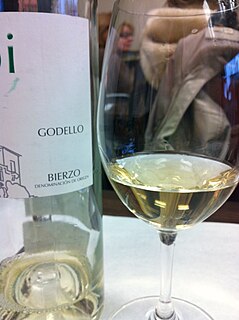
Godello is a white variety of wine grape grown in northwestern Spain, in particular in Galicia. The Gouveio found in northern Portugal is thought to be the same grape variety.

Piquepoul, Picpoul, or Picapoll is a variety of wine grape grown primarily in the Rhone Valley and Languedoc regions of France as well as Catalonia, Spain. It exists both in dark-skinned and light-skinned versions, as well as a very little grown Piquepoul gris. Piquepoul blanc is the most common of the Piquepouls, with 1,000 hectares cultivated in France in 2000, and an increasing trend.

Swiss wine is produced from nearly 15,000 hectares of vineyards, and the wines are mainly produced in the west and in the south of Switzerland, in the cantons of Geneva, Neuchâtel, Ticino, Valais and Vaud. White grape varieties are grown on 43% of the country's vineyard area, and red grape varieties on 57%.

Picardan or Picardan blanc is a white wine grape which is one of 13 permitted blending grapes within the Châteauneuf-du-Pape AOC in Rhône wine region in France, although very little planted. The Vitis International Variety Catalogue previously listed Oeillade blanche as the primary name of the variety, but now identifies Araignan as the primary name. However, since the variety is practically unknown for any other use than the Châteauneuf-du-Pape blend, it most commonly goes under the name used for it in that appellation.
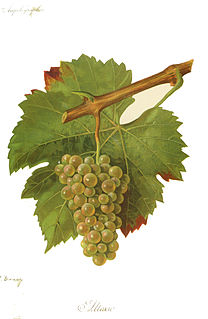
Altesse or Roussette is a white French wine grape variety found primarily in the Savoy wine region of France. It yields small harvests and ripens late but is resistant to grey rot. Wines made from Altesse have exotic aromas, often together with citrus and herbs, and have good acidity. They are considered to age well.

Amigne is a white Swiss wine grape planted primarily in the Valais region, with most of the plantations in Vetroz. Total Swiss plantations of the variety in 2009 stood at 43 hectares.
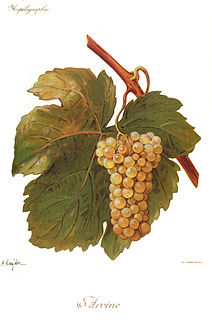
Petite Arvine is a white wine grape planted in the Valais region of Switzerland. Total Swiss plantations of the variety in 2009 stood at 154 hectares.
Baroque is a white French wine grape planted primarily in South West France around the Tursan region. It can make full bodied wines with nutty flavors. Ampelographers suspect that the grape maybe a crossing of Folle Blanche and Sauvignon blanc.
Cereza is a white Argentine wine grape variety. Like Gewürztraminer and Pinot gris, Cereza is a pink skinned variety. It is a crossing of Muscat of Alexandria and Listan negro.
Completer or Malanstraube is a white Swiss wine grape variety grown primarily in eastern Switzerland around Graubünden. The Completer vine was once domesticated but has now become mostly feral though some Swiss winemakers will make limited quantities of wine harvested from the wild vines. Wine produced from Completer tends to be very full bodied and aromatic.
Doradillo is a white wine grape grown primarily in the Riverland region of South Australia. It originates from Spain, and is also known as Blanquette of South Australia.
Gamaret is a variety of red wine grape. It was created by André Jaquinet at Station Fédérale de Recherches en Production Végétale de Changins in 1970 by crossing Gamay and Reichensteiner. Gamaret was developed for cultivation in French Switzerland, and is a full sibling of Garanoir, which was intended for the German part of the country.
Garanoir is a variety of red wine grape. It was created by André Jaquinet and Dominique Maigre at Station Fédérale de Recherches en Production Végétale de Changins in 1970 by crossing Gamay and Reichensteiner. Garanoir was developed for cultivation in German Switzerland, and is a full sibling of Gamaret, which was intended for the French part of the country.
Cornalin d'Aoste or Humagne Rouge is a variety of red wine grape. It was named after the Aosta Valley in northwestern Italy where it was wrongly presumed to have originated, but where it is now almost extinct. It is primarily grown in the Valais region in Switzerland, where it is called Humagne Rouge, and the total Swiss plantations of the variety in 2009 stood at 128 hectares. The wines produced from the variety are wild, rustic and high in tannin.
Rouge du Pays, also known as Cornalin du Valais or Cornalin, is a variety of red wine grape. It is primarily grown in the Valais region in Switzerland, where it is often called Cornalin, and the total Swiss plantations of the variety in 2009 stood at 116 hectares. It produces deep-coloured wines that typically need aging, and is something of a speciality of Valais.
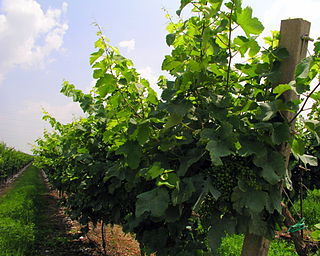
Glera, also known as Prosecco, is a white variety of grape of Slovenian origin, which was brought to the village of Prosecco from the Karst region. The variety was formerly mostly referred to as Prosecco, but in the EU was renamed "Glera" in 2009 to make room for the protection of "Prosecco" as the name of a geographically-protected wine.
References
- ↑ Humagne Blanc Archived 2012-04-22 at the Wayback Machine , Vitis International Variety Catalogue, accessed on June 20, 2010
- ↑ Office fédéral de l’agriculture OFAG: Das Weinjahr 2009 / L'année d'viticole 2009 Archived 2011-07-07 at the Wayback Machine
- ↑ J. Robinson Jancis Robinson's Wine Course Third Edition pg 112 Abbeville Press 2003 ISBN 0-7892-0883-0
- 1 2 Jancis Robinson, ed. (2006). "Humagne Blanche". Oxford Companion to Wine (Third ed.). Oxford: Oxford University Press. p. 347. ISBN 0-19-860990-6.